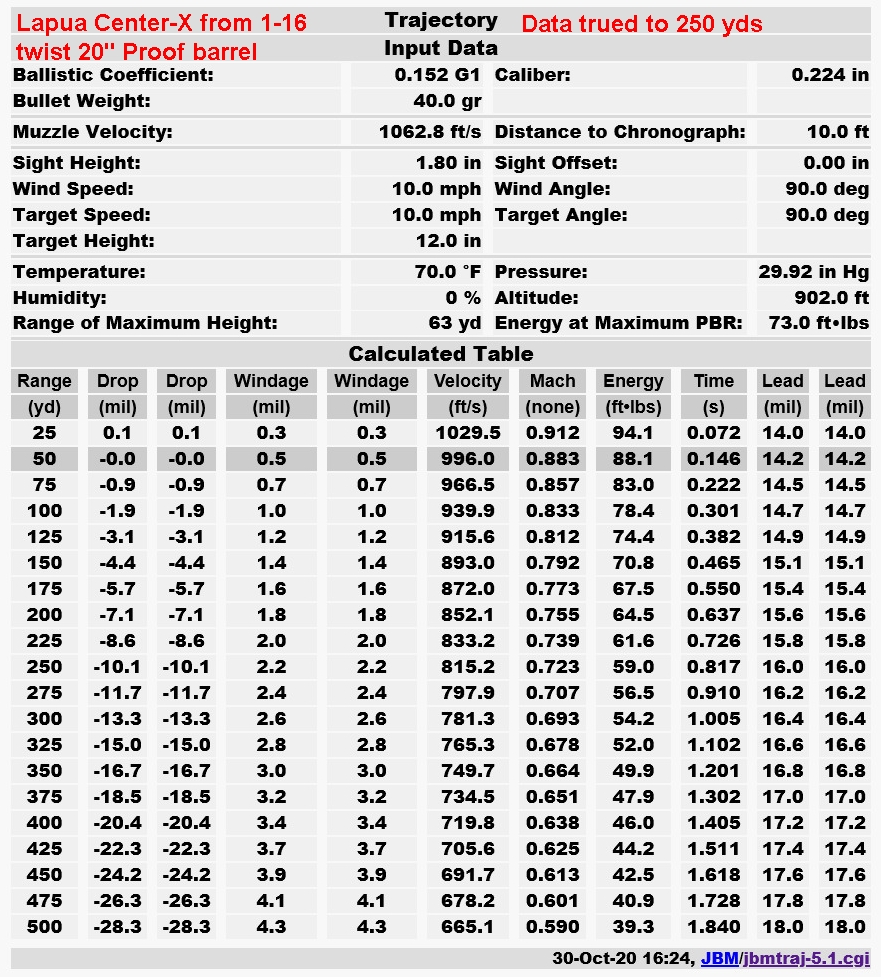
BigJimFish
Written: Nov 12, 2020
Table of Contents:
– Introduction
– Vudoo V-22 Core Technologies
– Other Unique Features
– Fit, Finish, and Physical Description
– How They Shoot
– Ammo Choice Discussion
– Feeding and Ejection Reliability
– Summary and Conclusion
Introduction:
I think I first heard of Mike Bush somewhere around 2012. At that time he was modifying single shot discontinued Remington 40x rifles into repeaters that fed from a 3-D printed magazine he was making. His work had a good reputation. At that time I did not realize this was prototyping for him with the goal of re-introducing an updated 40x that would be a repeater instead of single shot based on his designs through Remington. I was not really interested in expensive modifications to an already expensive used 40x, and so, not having not found the true to scale .22lr of my dreams, I was separately trying to convince a few action makers to produce .22lr 700 platform custom actions using an AICS compatible adapter block I sketched out for them with a sleeve adjustable in two dimensions housing a Marlin 880 magazine instead of the AICS sized standalone .22lr magazine concept Mike was working on. I frankly never thought that an AICS .22lr magazine could be made reliable without any end user adjustability. I thought the variance from chassis to chassis to bottom metal on dimensions was just too great. Nobody that I harassed had any interest in working on 700 footprint .22lr receivers (pretty funny now isn’t it), so, when I eventually acquired a suitable full scale .22lr, I ceased to think much on the idea.
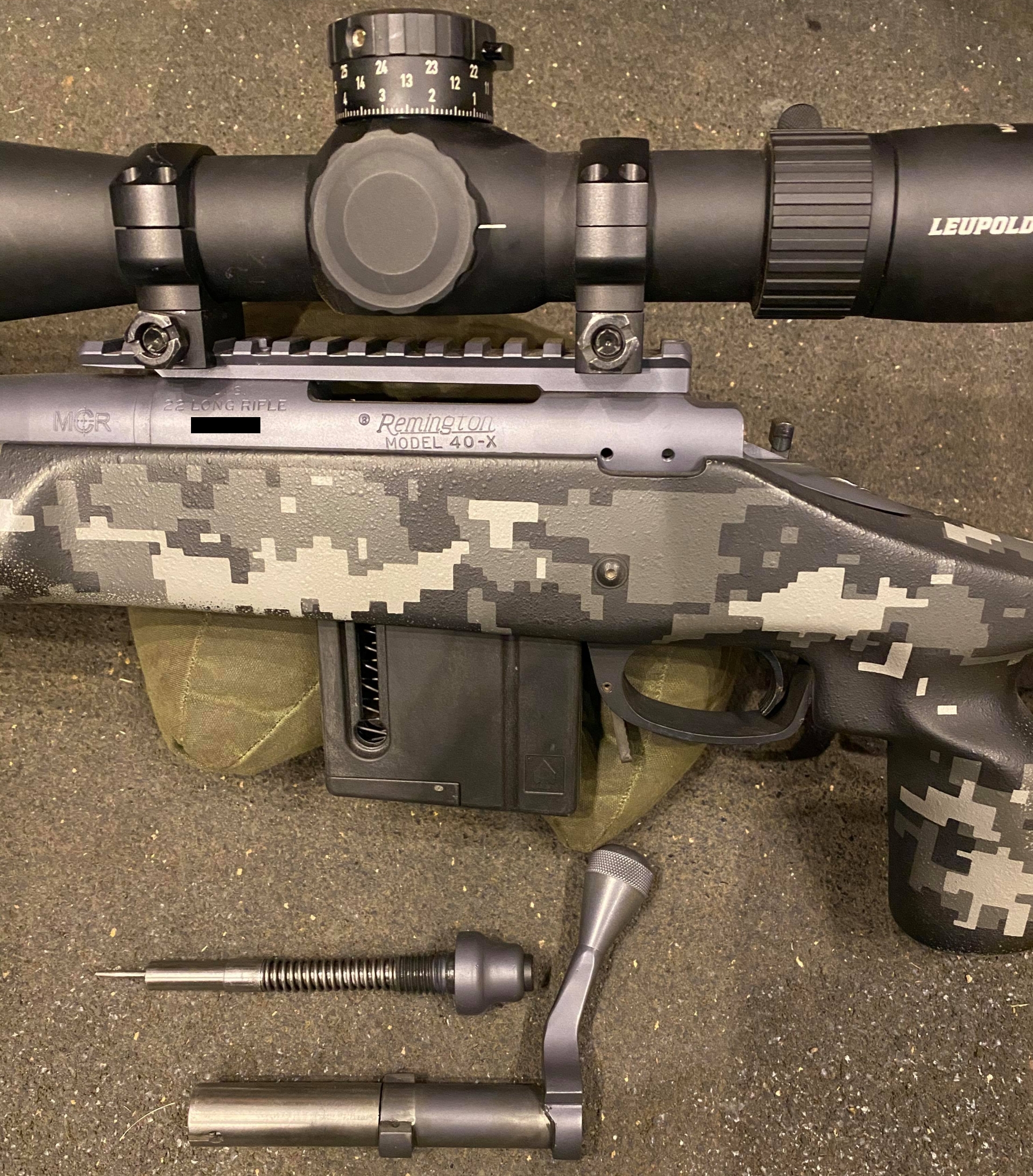
Focus was changing for Mike as well. Remington did not end up deciding to do the project with him. Instead, they went for general self-immolation on unrelated grounds. Mike ended up joining with Paul and Jill Parrot to form Vudoo Gun Works to produce a much higher grade of the concept than he originally anticipated. I sort of watched this from afar until last year when I wanted to do some harmonics testing on a Proof carbon fiber barrel in .22lr. I needed a solid platform, solid smith, and access to steel barreled versions of the same platform cut by the same smith. I was investigating this path when the Lapua test center opened up in Ohio and made things even easier since it regularly tested steel barreled Vudoos. Given the good things I had heard, I was pretty excited at the confluence of factors. I asked Mike if he was interested in this investigation and he came onboard. As long as I was using a Vudoo and collecting data from a bunch of Vudoos, I figured a review was also in order. After all, what other review is going to have data from seven different Vudoos shot under near ideal test conditions.
Vudoo V-22 Core Technologies
We should start this off by saying the V-22 is NOT a 40x repeater conversion. Both the 40x and the V-22 have a Remington 700 footprint and accept 700 triggers, but that is about it for similarities. The first thing is to understand that the 40x is essentially a Remington custom shop modification to a 700 short action. They started life being pulled from the 700 production line partway though. This results in some compromises as far as fitness for the .22lr cartridge is concerned. Most notably, the lug raceways extend the full length of the receiver even though it is a mid lug action. This results in the front, non-rotating, part of the bolt not being supported by the action body, but rather by a strange spring-loaded alignment guide fitted into the left lug raceway. This results in some play in where the bolt nose can actually end up and, therefore, some variance in where the firing pin strikes the case head. The V-22 has lug raceways that only extend to the lugs. In front of that, the receiver is narrower and supports the forward non-rotating bolt section with its body. Vudoo holds U.S. Patent # 10,495,394 relating to this. The patent is essentially for the idea of press-fitting and welding a cylinder inside of the front of the action, resulting in the smaller diameter forward section. In addition to supporting the nose of the bolt, this construction method furthermore lowers the cost of production, as Vudoo can mill the shorter resulting lug raceways in the rear of the receiver instead of EDM or broaching full length raceways. This is why Vudoo’s lugs are rounded instead of rectangular. It probably also contributes to why Vudoo bolts feel so smooth. EDM does not actually produce that smooth of a surface. It is essentially electrical erosion and is not as smooth as cutting with a bladed tool.
In the same vein as supporting the bolt nose with the action body, Vudoo also better supports and guides the firing pin. The firing pin on a 40x comes to a stop on the cocking piece near the back of the firing pin. This is a long way from where it’s impacting the case – at the front. The V-22 firing pin is stopped on the inside of the front of the bolt, near the front of the case. This difference is also why the V-22 is entirely dry-fire safe though you will probably still cringe to do so from the years of training not to dry-fire .22lr’s.
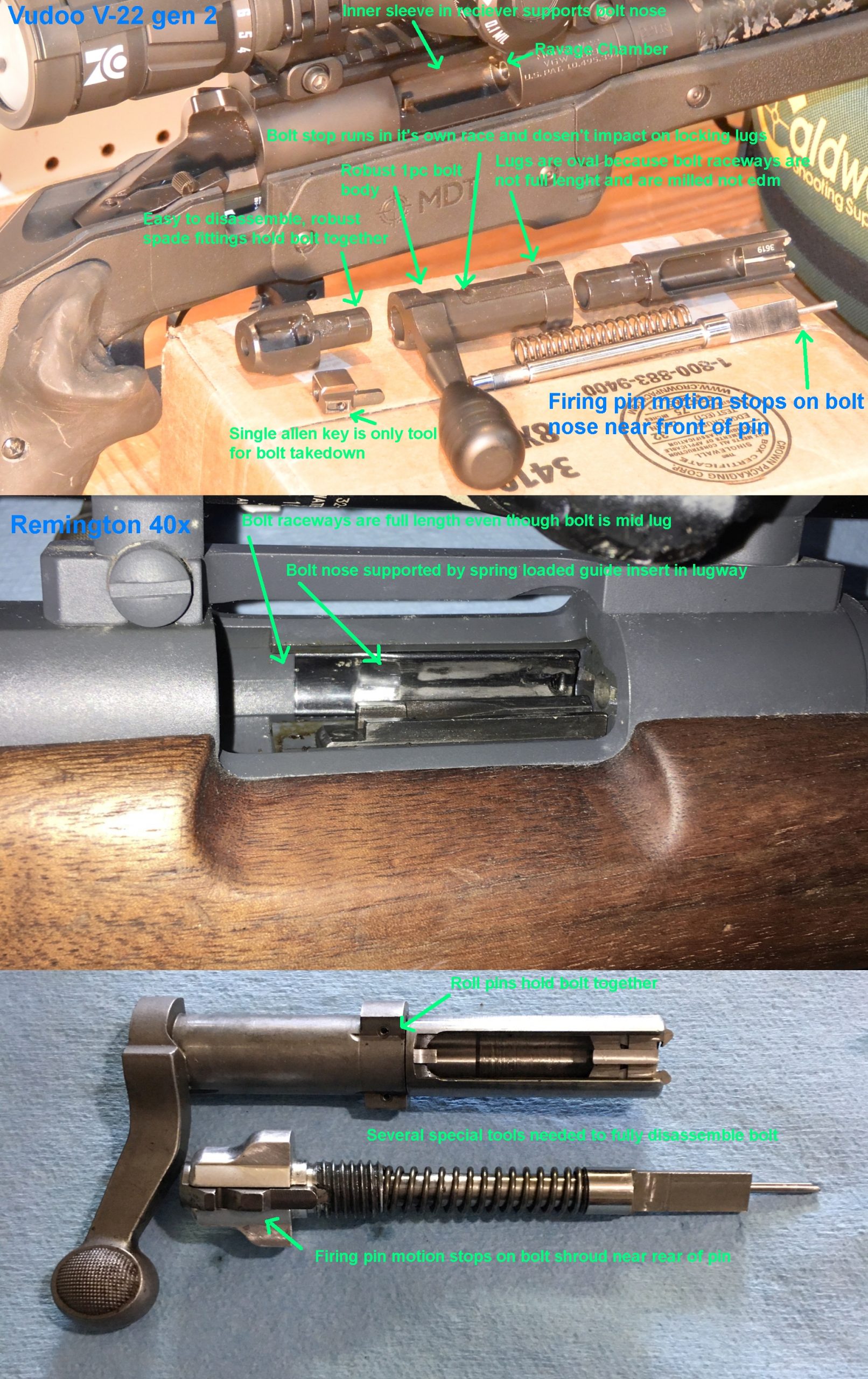
As Vudoo has updated its design over the short duration of its manufacture, Vudoo has further distanced its firing control system from the 40x. Originally, the cocking piece was a simple Remington 700 piece, like the 40x, and the bolt disassembled using the same special tools. On current production (gen 2) V-22s, Vudoo uses its own cocking piece, which is threaded instead of pinned to the firing pin. This allows tighter tolerances and also allows for the entire bolt, even down to the firing pin spring, to be disassembled with only an Allen key, though I would suggest using a wood-jawed vice while doing so as that will make it much easier. The V-22’s firing pin has a unique half moon shape to its tip which follows the contour of the rim. It is the single largest area firing pin tip I have ever seen, engaging at least twice the area of any other .22lr firing pin and making it pretty unlikely that you will suffer an ignition failure from striking an area of the rim with a priming compound gap. The standard firing pin spring is 18lbs and is optimized for soft Lapua brass. When I used the standard spring on harder Eley and CCI cases, I still had ignition 100% of the time, but I did notice the indentation in the case rims from the firing pin was pretty light. A 22lb firing pin spring is available for those harder cases and, given the easy takedown of the bolt, is pretty easy for the user to install.
Perhaps Vudoo’s most obvious piece of new technology on the V-22 is the AICS footprint .22lr magazine. It is not so much that the idea of a big form factor magazine necking down and holding .22lr cartridges is new (Ciener pattern .22lr magazines that fit unaltered AR-15 lowers are pretty common), it is more that Vudoo produced an AICS form factor .22lr magazine which, in concert with their bolt, manages controlled round feed and works well in most examples of most chassis. The Ciener, and most other .22lr systems have a feed ramp. This is not ideal with soft lead .22lr bullets. It is really essential for best accuracy to go from the magazine into the chamber without scraping on a hard steel feed ramp. Accomplishing this was the primary goal of the years of trials with 40x conversions that Mike did.
Next on the list of Vudoo’s major technologies is the ravage chamber. As we will discuss later, the V-22 is best consumed in barreled form so you will most likely be buying one with the ravage chamber, though they can spin one up for you with one of the other popular match .22lr chambers such as the EPS if you are an Eley fan. The ravage chamber is based on the Winchester 52d chamber but is altered some to best fit the Lapua bullet and to be able to extract that round unfired as well. The 52d is probably the tightest of all match chambers. The ravage is closer to average for match chambers. It will extract unfired Lapua and most, but not everything, else. CCI in particular may chamber hard and fail to extract. Having tested a good variety of .22lr in the ravage chambers of several Vudoos I have found it to shoot a variety of ammo well.
Other Unique Features
In addition to the major technologies mentioned, Vudoo also incorporates a few smaller unusual changes. The first of these is an easy-to-remove ejector. The ejectors on .22lr often protrude into the line of the bore and therefore can damage your cleaning rod or require you to use a .17 caliber one. Vudoo has made their ejector very easily removable with a single screw accessible though the mag well with the stock attached. I suggest you remove it for each cleaning.
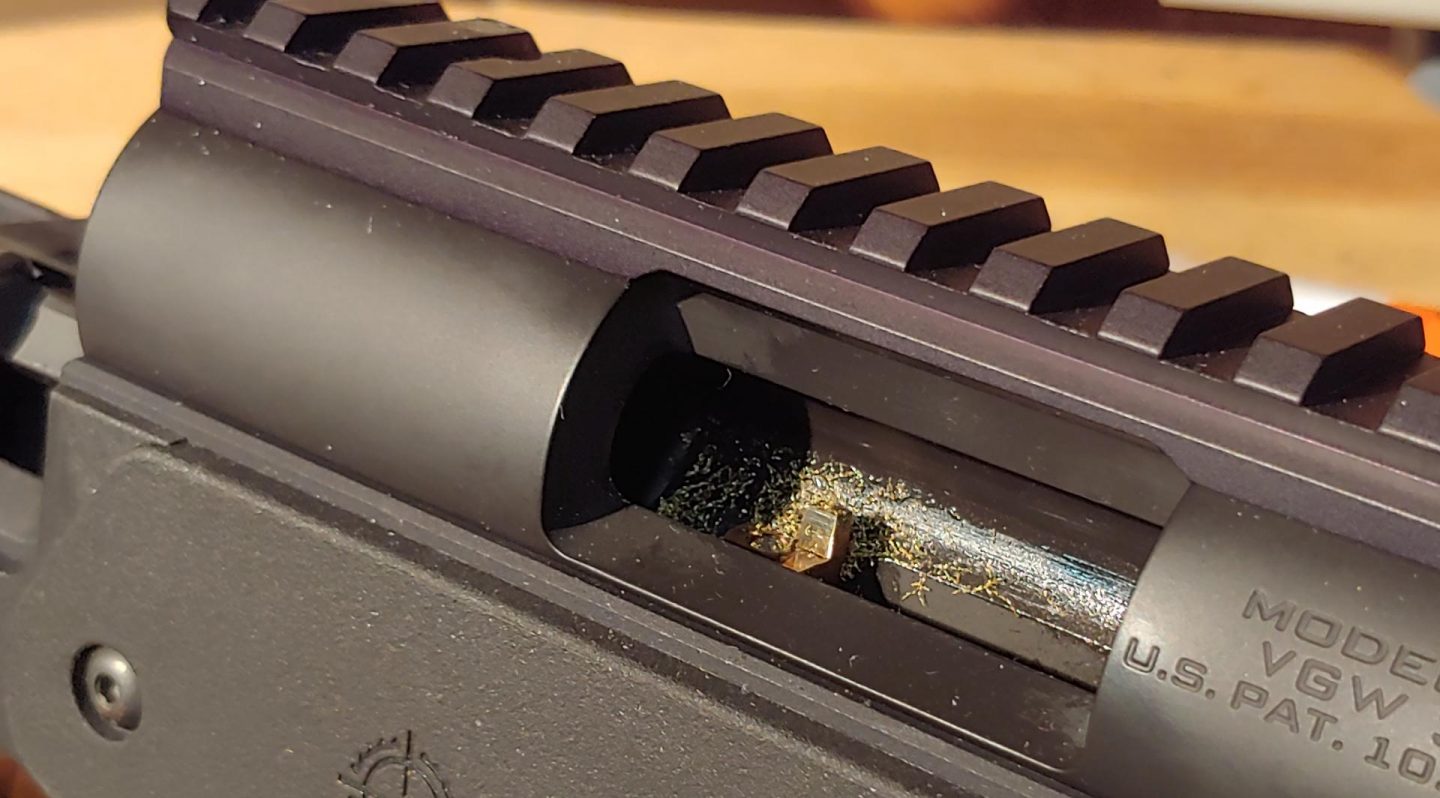
Along the theme of cleaning. Vudoo has designed a unique hybrid cone breach on the barrel which has a good bit of bulk around the chamber but also features relief towards the edge of the breach face so that crud has a place to go and not interfere with the bolt closing in the event you are running a silencer or just going a long time between cleanings. The first generation of this hybrid breach was almost to a cone breach but the later is almost to a traditional flat breach. You can order with either of these or a traditional breach like I did if you don’t tend to run dirty.

Virtually all match grade .22lr rifle barrels are 1-16 twist and button rifled, often with odd rifling profiles and taper lapping. These were the things that the consensus in the community deemed desirable and most effective. Mike was not convinced and, after a good deal of testing, disagreed. The barrels he uses for Vudoo’s house Ace barrels are cut rifled as are all the others (Bartlein, Krieger, and Proof) that Vudoo commonly stocks and installs if customers so desire. For those not aware, cut rifled barrels are more, not less expensive to manufacture. Mike first started to consider barrel twist rate in the .22lr when he found that the BC he was seeing in the real world from .22lr at range was not as good as expected. He thought that perhaps the .22lr is not totally stable as it gets further down range and its rate of rotation decays. It is common in short range benchrest disciplines to run twist rates on the ragged edge of stable as the less the overspin, the better accuracy will be, so long as you don’t cross into unstable territory. Mike figured this might be what was happening and tried some other twists. Most were terrible failures but he eventually got 1-9 working and he found them to have an advantage in both accuracy and drop as distance increased. Vudoos can now be ordered with 1-9 twists as well as 1-16.
Over the course of the astounding 4k+ V-22 actions that Vudoo has made in just these last four years, they have gone through three slightly different versions of their repeater action, produced a V-22m long variant for 17hmr and .22mag, and also produced a V-22s single shot variant. They have chosen to name the generations of these actions in a truly confusing way. They have a gen 1, 1.2, 2, and 3. The 1, 1.2, and 2 all represent different bolt designs for the repeater actions. The gen 3 is only found in the single shot V-22’s benchrest action. The action I have on my review rifle is a gen 2 V-22 and that is the only variant I will be talking about because if you buy a rifle today that is what you will get. If you are interested in the differences between the variants and how each disassembles, Vudoo has produced a video detailing the disassembly procedure of each generation of action which amply illustrates the differences between them.
Fit, Finish, and Physical Description
V-22 actions cost a custom price and they are machined to that level. The V-22 is one of the smoothest custom actions I have ever run – and I have run more than a few. Being a .22lr action, the V-22 has a good deal more complexity than centerfire actions. Each part of the bolt as well as the shroud are held together with spade fittings. The fitment of these pieces is excellent as is the fit and machining on the firing pin which runs though all of them. The machining on the crown and in the chamber also appeared excellent. The chamber has a fine mirror finish and the machining on the crown is quite clean and with no markings on the inside of the bore. The crown appears to be both recessed and 11 degree. Sort of a combination of the common recessed crown seen on most centerfire guns and the Anschutz 11 degree crown. As with the part fitment and machining, the finish is also of good quality and excellent craftsmanship. The action comes Melonited standard, though you can also choose to have it Cerakoted. The barrel is Cerakoted standard. Vudoo barrels come standard threaded with the 1/2 x 28 TPI pattern common to rimfires and include a thread protector finished to match the barrel.
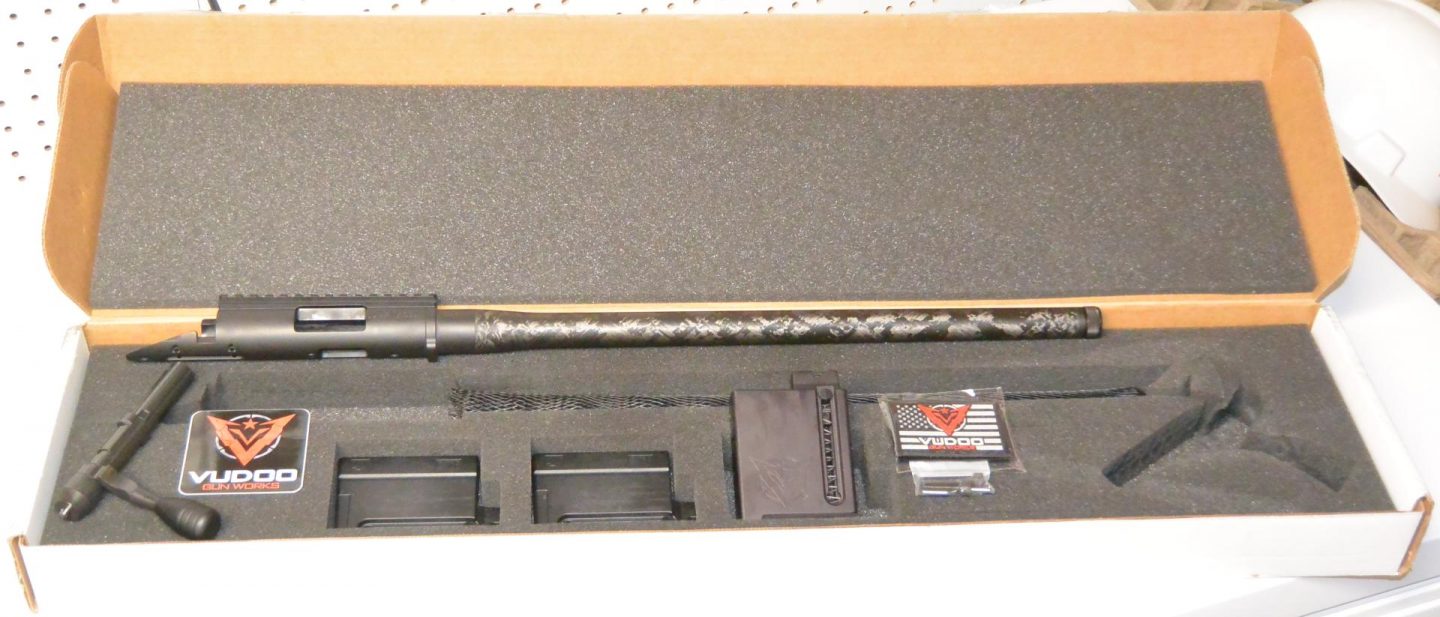
As previously mentioned, the action of the V-22 is constructed in two pieces with an inner sleeve to support the bolt nose extending as far back as the lugs being press fit into the full length outer receiver. The fit is quite good and I had not noticed the joint between the two until I specifically looked for it, as it passes for a fine machining mark. The V-22 action is of the lathe-turned variety and, as such, the rail is a separate piece of metal. It can be purchased in 0-60moa inclinations with 30moa being standard.
The recoil lug on the V-22 is integral and I think is a bit unfortunate in dimensions. Being a .22lr and therefore having little recoil, the lug protrudes into the stock much shallower than a centerfire lug. For some reason, however, it is actually far thicker than the average centerfire 700 pattern lug. I think this is an unfortunate choice because it would have been quite possible to make the lug slightly smaller than most centerfire recoil lugs in all dimensions save the location of the rear of the lug. In this case, the Vudoo action would have been able to drop into stocks bedded for centerfire rifles with likely good results. Lathe-turned actions might not be as trendy as those with integral rails, but their external dimensions are straighter and rounder, and this would have allowed people to run their Vudoo in an action bedded for their centerfire with no fuss and, I suspect, good results. When I first saw an image of the receiver with its small lug, I thought this was the plan. Sadly, no. The recoil lug dimensions and the use of standard trigger pins instead of a hanger or shouldered threaded pins are the only improvements that have come to mind in the process of doing this review.
Also integral in the V-22 is bolt handle. This is uncommon in most centerfire actions. Usually the bolt handle is welded to the bolt body. The integral handle is a stronger solution. The bolt knob is threaded as per usual with three standard offerings. The medium knob is present on the rifle constructed for me.
How They Shoot
It is unusual when doing a review to have a substantial amount of data from a variety of examples of a product, many of which were purchased on the open market and all of which were tested under near ideal and near identical situations. I have certainly never been able to provide that sort of depth, quality, and quantity of data before, but today is all our lucky day. I have data from seven different Vudoo rifles, all but two of which were purchased on the open market. I am fairly certain that all of the Vudoos except mine had ACE barrels with most being the Kukri profile, though I think there was an MTU or two. Of course, mine was the Proof carbon barrel used for the Proof barrel review that started this project. All of the rifles tested were chambered and barreled by Vudoo with their ravage chamber. The rifles were tested under indoor conditions at the Lapua test center with a variety of Center-X and a few Midas+ lots for the purposes of lot selection. Because the purpose of testing for most of the rifles was ammunition lot selection for purchase, a sub-optimal factor in the data is that there is variability in how many shots of each lot of ammo were fired, precisely what data was recorded for each, and how much of that data made it to me. The rifles were also not all tested at the same time and so the lot of ammo used varies. This presents both advantages and disadvantages in that lots of different ammo was tested, but not across the same set of rifles. In the end, I think the compiled data provides a pretty good idea of what sort of performance to expect from Vudoo’s products, even if it doesn’t answer all of my questions.
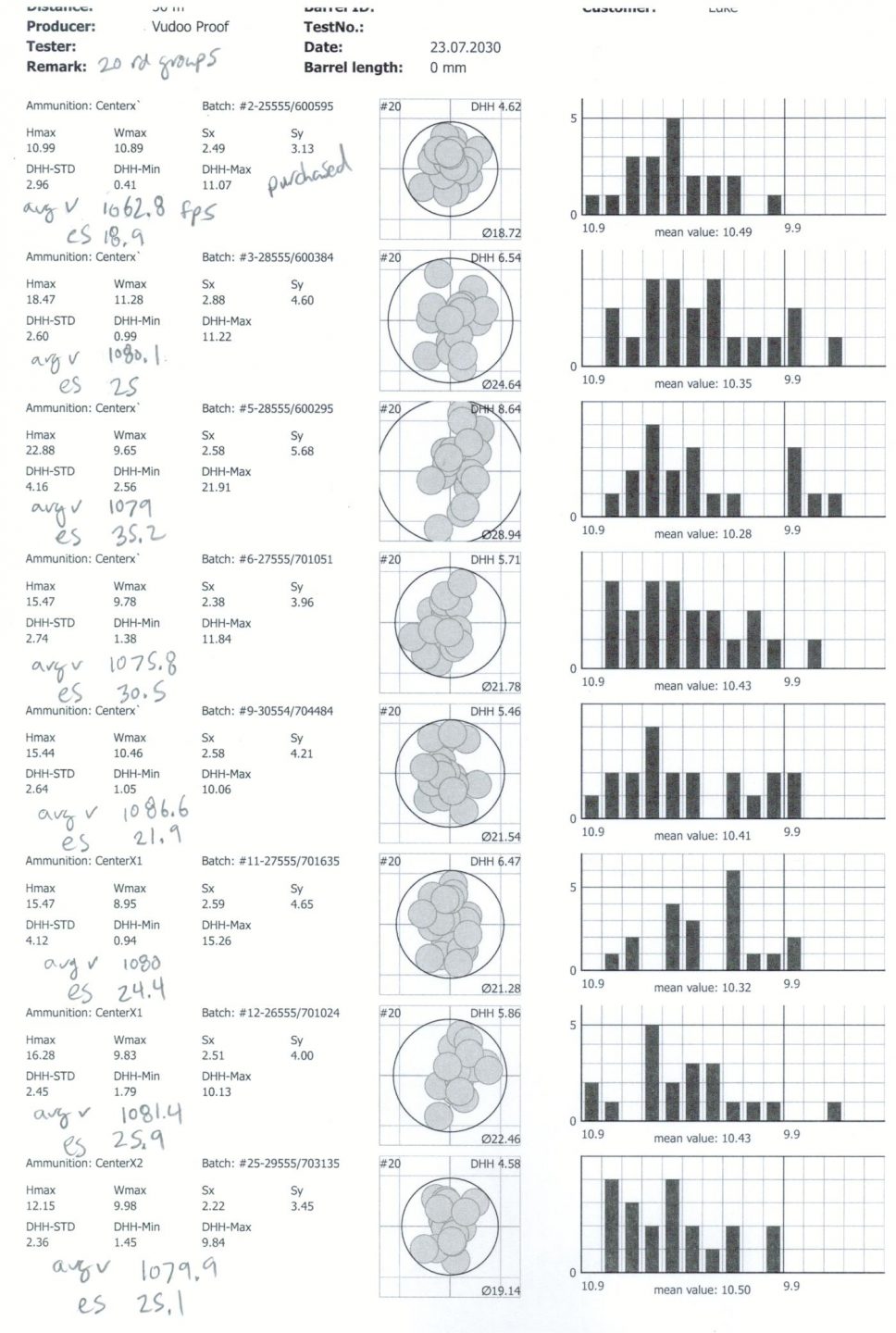
For the purpose of this review I have focused on the performance of the best, worst, and average for all lots of ammo. The Group OD (mm) is the diameter circle necessary to surround all shots in a group completely. This is not a center-to-center measurement, but an outside edge to outside edge one. It also incorporates all shots fired, not just the two furthest apart. Because I think most readers are used to measuring the center-to-center maximum extents at 50yds or 100yds, I have converted the metric to English, made an adjustment for 50M vs 50yds, and subtracted the diameter of the bullet so it is now the diameter that incorporates all the centers instead of the outside edges. This is still not the simple furthest extents that most shooters use because it has to fit all the shots, not just the two furthest, but it is as close as I can get given the data that I have for all the rifles and close enough that I think shooters will be able to get a feel of the performance of the Vudoos relative to rifles they have used in the past. With the Vudoo data, we are also dealing with 10 or 20 round groups and not the 5 round groups most shooters use. Anybody who has shot a lot of consecutive 5 round groups to the same aim point at different targets should understand how substantially a single 20rd group typically differs in size from the average of four 5 round groups. Statistically speaking, the DRMS number is a much better measure of precision than OD which is better than the extents most shooters use. The DRMS is the size circle predicted to fit 63% of the center points of all future shots in it. This is something like a two dimensional standard deviation. For those interested. Doubling the size of the DRMS gives you a diameter predicted to fit 98% of center points in it. I have marked how many shots were fired per group in the data below. Keep this in mind as 20rds is a lot more than 10, which is a lot more than the 5 most shooters use. The software in the shot tracking software Lapua uses is very good, but it does have some limitations. First off, their chrono does not calculate SD, only extreme spread. Also, the software is set to create composite groups and composite DRMS numbers at 50M but only gives 10 round groups at 100M. For this reason, a 100M group for the same lot can be substantially smaller than twice the 50M group as the 50M group is 20 rounds and the 100M one will be the better of the two resulting 10rd groups.
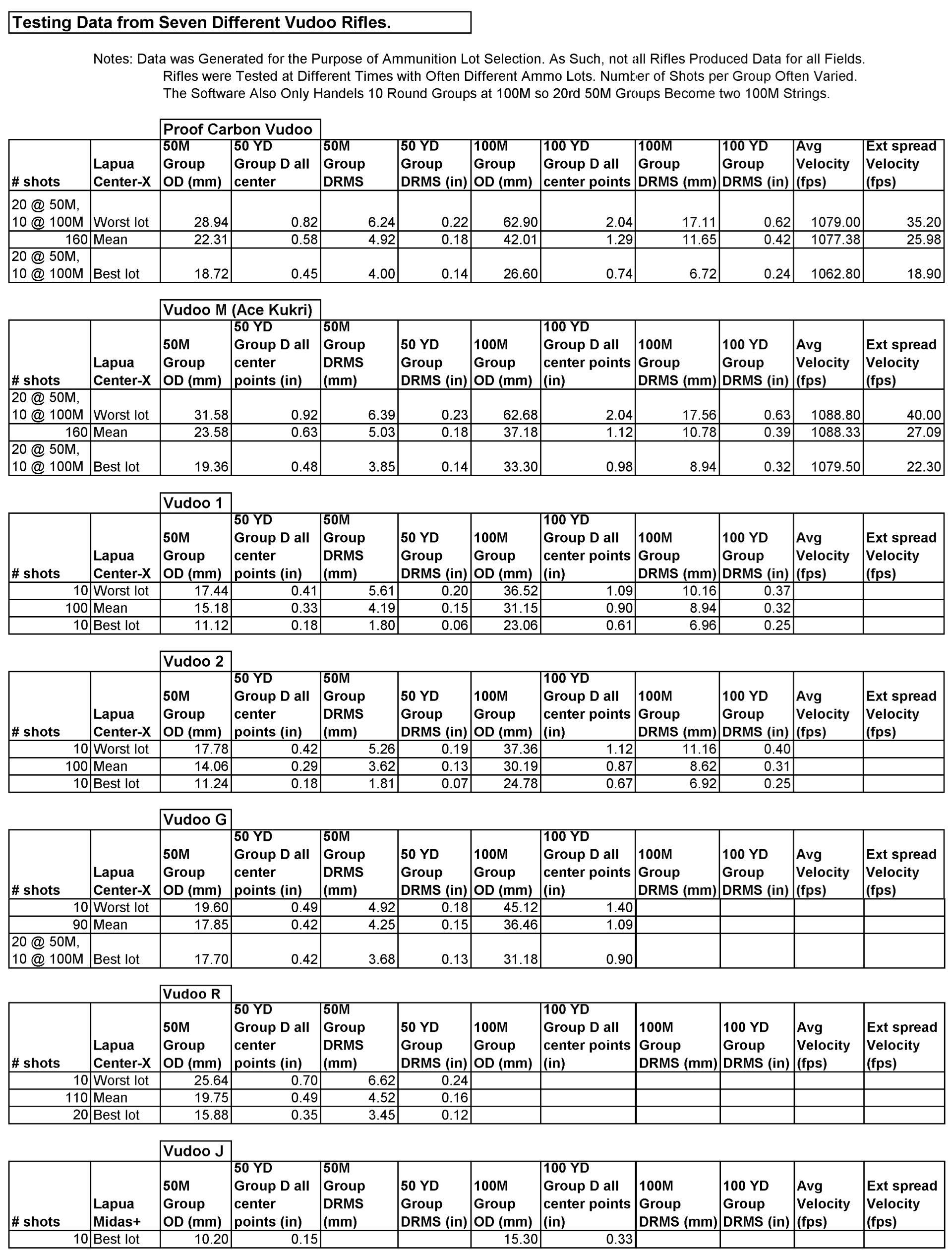
Those are some pretty impressive numbers aren’t they? The one thing I did find maddening in the data was the 10 shot rifles. Specifically, Vudoos 1 and 2. Predictably, these posted significantly smaller group sizes and DRMS numbers than the others, but these furthermore posted groups smaller than any of the individual 10 round groups from the other rifles whose groups were combined to make the 20rd groups. I find this maddening because I do not have enough data to know if these rifles were a bit better than the other Vudoos, if they got some better lots, if they just got a lucky small sample size, or if it is a bit of all three. To support the lot hypothesis, I have data from some other high-end benchrest and 3-position guns fired with those lots and their performance was similar. On the other side of the argument, Vudoo G fired the same lots as 1 and 2 but did not have the same level of success. Further complicating things, Vudoo G was also tested with Midas+ and did have groups in that range with the Midas+. The Proof Vudoo, M and R all had entirely different lots, with the Proof and M sharing lots and R having lots all to itself. In any case, I don’t think it enough data to conjecture whether Vudoos 1 and 2 just shot lucky groups, lucky lots, or are particularly exceptional examples. In any case, I think the data collected is more than enough to give a darn good idea of what to expect from a Vudoo rifle. Every one of the rifles tested was less than .5″ @ 50yds even with 20 rd groups.
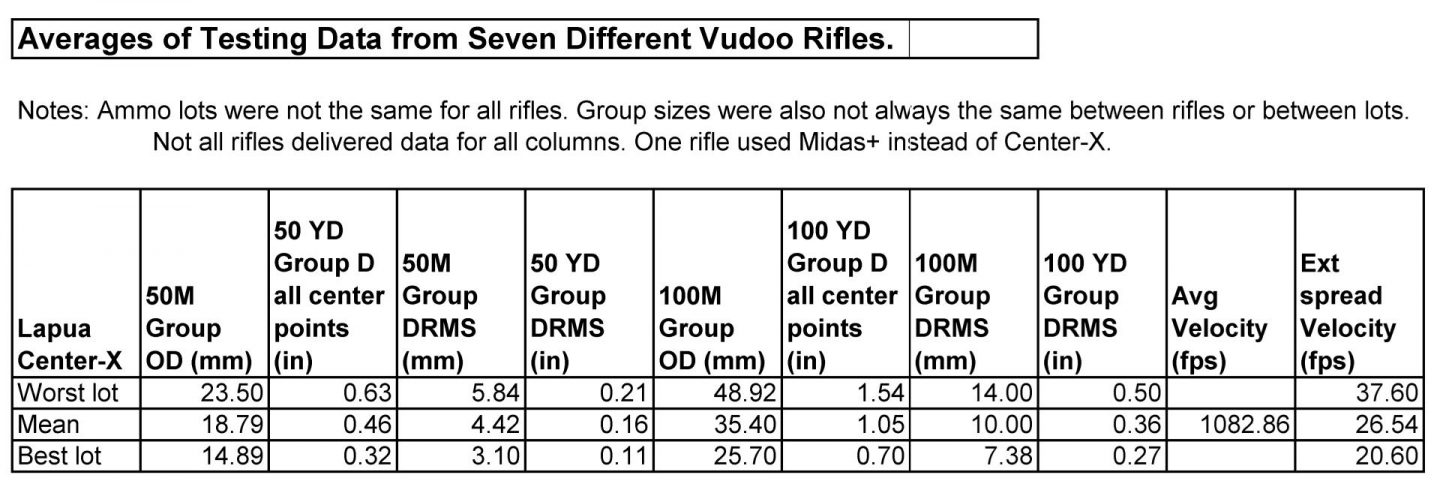
What I have shown in this table is to help you see the range of performance to expect from a Vudoo rifle paired with the Lapua Center-X it was most designed for. If you go though the lot selection process yourself or at a test center, you should expect to find a lot that gives you a DRMS @ 50 yds in the range of .11″. The worst any rifle did on this was .14″. I expect that using the conventional 5 shot groups with extents measurement, you would probably average significantly better than .5″ groups at 50yds. Probably, quite close to .25″. At 100yds, the average DRMS was .27″ with the worst rifle at .32″. I expect this will come out around .75″ average 5 shot group sizes, which is pretty amazing given that true sub-MOA .22lr’s are a rare thing.
I hope that the above data is also convinces the reader of the value of ammo lot selection as the expected improvement for going through the lot selection process is not only large, but also a bit better than the expected improvement from stepping up in grade from Center-X to Midas+ or X-act. However, if you do decide to lot test Midas+ or X-act along with Center-X, more than likely your best performance will be with a lot of the higher cost fodder. The relatively little data I have from folks that tested Midas+ as well as Center-X suggests that the difference can be quite substantial and that in many cases, all of the Center-X lots available are significantly limiting the Vudoo’s performance. It is important to understand that Midas+ and X-act start off their lives in the same production line as Center-X. Lapua tests its production lots and the best end up as those higher cost products. The same is true for Eley with Ten-X and Match. I suspect that Lapua does the same thing as Eley when too many lots to sell as the higher grade product test to that level: some of the higher grade are just marked as lower and so we all hunt for them.
Before we leave this section, I should address how Vudoos stack up with other top tier .22lrs. In addition to compiling this set of test data from these seven Vudoos, I have also seen a substantial amount of data produced in the same manner from a variety of Anschutzs, Walthers, 40xs, and even some benchrest stuff smithed by top guys in that game. Vudoo is clearly producing .22lrs that are reliably comparable in accuracy to the top Olympic positional rifles and occasionally, even to some benchrest stuff. This is quite an accomplishment given that the Vudoo is a repeater and they are performing on the level of the best and most expensive single shot rifles.
Ammo Choice Discussion
We have focused a lot the performance of Vudoo rifles with Lapua Center-X ammuntion. The chamber shape, feeding, and firing pin spring force on Vudoos have all been designed for use with the Center-X family of ammunition – and Lapua in general since most of their ammo line from Sk Std+ to X-Act uses the same bullet shape. Unsurprisingly, a number of people have inquired as to the suitability of using the Vudoo rifle with other ammunition. With the exception of the 60gr Aguila SS ammo which will not stabilize in a 1-16 twist, and whose short case won’t eject properly either, I have had no problems. Basically, the Vudoo fed, fired, and ejected whatever I put though it without a flaw and the accuracy with each ammo was within the range I would expect that ammo to be capable of given my past experience with each type out of other match rifles. In fact, the Vudoo M had its best group with one of the Eley Match lots. A few of the ammunition types, specifically CCI and Eley CMP, had some hard bolt closes that I expect would not have been extractable live, but the .22lr is a healed round so a hard close does not push the bullet back in the case causing high pressure or an errant shot. It is possible that some of the harder brass, again CCI and Eley, might have needed the stiffer firing pin spring if coupled with a different, higher parasitic loss, trigger, but I had no issues with ignition with the lighter spring and the TriggerTech two-stage I was using. Basically, I found departing from the Laupa family to be a complete non-issue from both a function and performance standpoint.
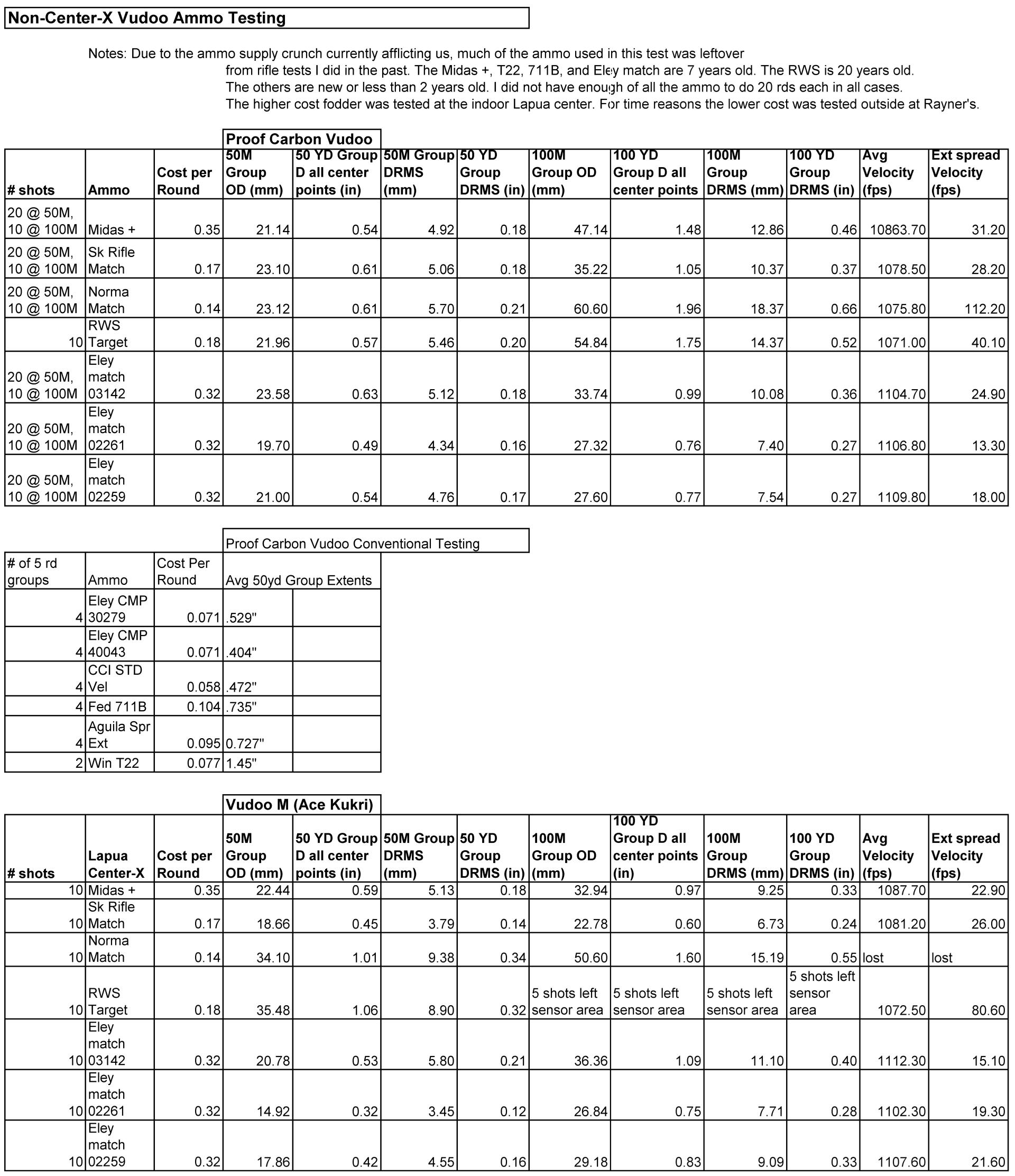
I’ll talk a little here about philosophy of ammo. I don’t use bulk Wally World high velocity copper washed garbage in any of my rifles. I also don’t fire Center-X every day. My habit for a number of years has been to use lot-selected Center-X for matches and other times I need the best performance, such as shooting long range. When practicing or plinking, I use CCI Standard Velocity because I feel that it gives great performance for the price. I basically don’t shoot anything between those two or more costly than Center-X because nothing else has really jumped out in value though some of the performance data with Midas+ in some of the rifles tested has me thinking perhaps I should reconsider. One or two hits in a match can easily be the difference between first and 5th place. I was recently introduced to the Eley CMP (Civilian Marksmenship Program) stuff and I have found it an excellent value and added it to my regular list as well. It may eventually totally supplant CCI Std. as my practice and plinking fodder. I think I have a pretty good ammo strategy and would recommend it to others but I’m sure there are many others happy using other strategies such as just riding the Laupa / SK line from practice to match use. But don’t be that guy who tries to use Wally World bulk pack in your $2k+ rifle even in competition. It’s not a functional practice and you will not get better shooting ammo so poor you have no ability to discern what mistakes were yours and what was bad ammo.
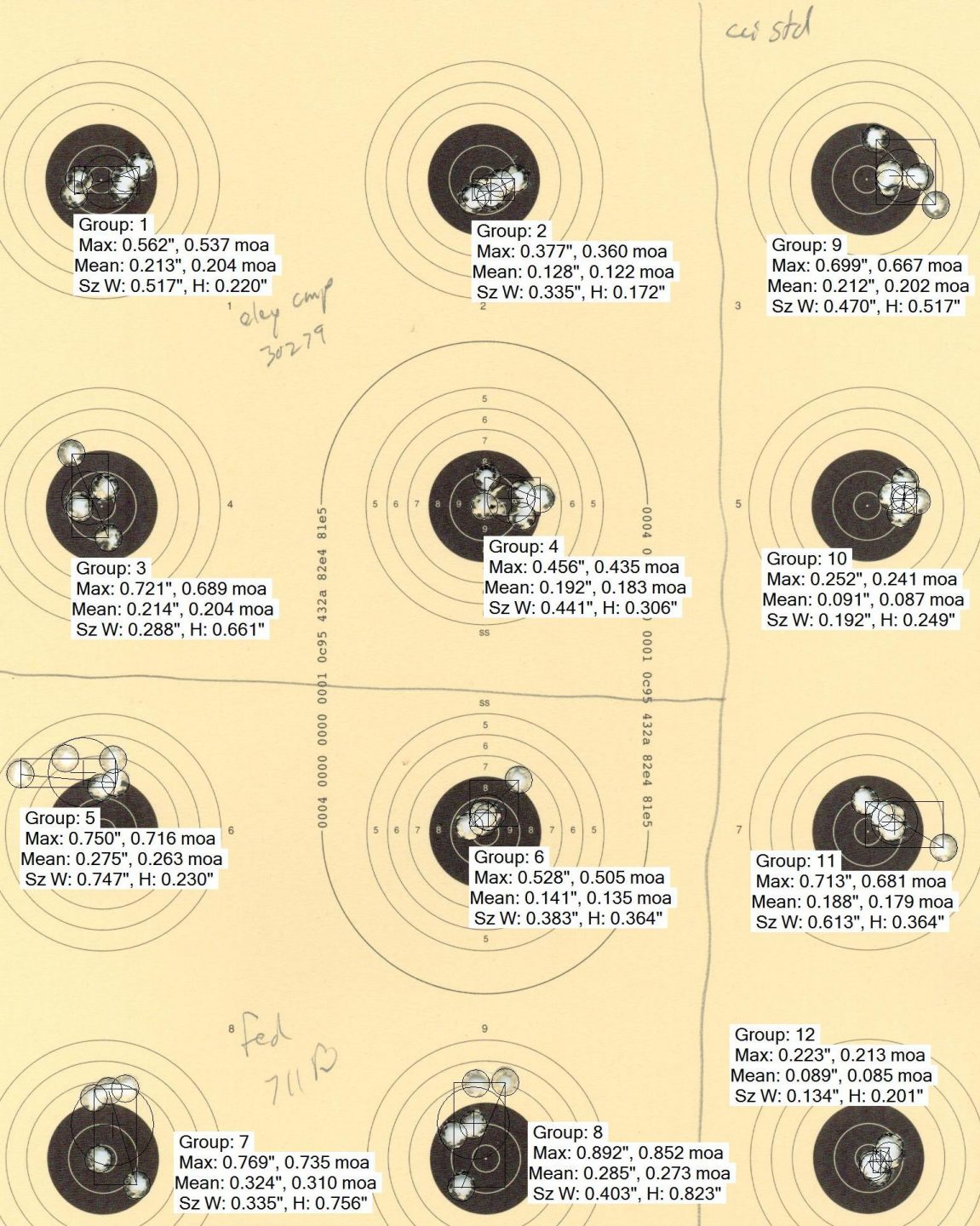
Feeding and Ejection Reliability
I cannot express how much testing it must have taken to design an AICS form factor magazine that could feed .22lr reliably in the plethora of chassis and bottom metal options that now exist for the AICS / 700 platform. Prior to the Vudoo’s introduction, I did not think it could be done without adjustability in the mag. AICS compatible chassis and DBM for stocks are simply not all exactly the same dimensions. I have even encountered some chassis that would not fit all available AICS compatible centerfire magazines. Despite this, the Vudoo magazines seem to only occasionally have had problems with a few stocks / chassis. If you do happen to be one of those few who has a feeding related to chassis dimensions, contact the Vudoo folks as there are steps that can be taken to remedy it.
When testing my Vudoo barreled action in the MDT XRS chassis, I had only two misfeeds the entire course of my testing. Keep in mind that I tested 12 different ammo types in that chassis and well over 1k rounds. Both of the misfeeds turned out to be rounds that I had improperly stacked in the magazine when loading them. By this I mean that a round above in the magazine had its rim behind a round below instead of in front of it. This causes the top round, when advancing forward, to angle down and jam into the front of the magazine. Obviously, this is my fault and not a failing in the rifle. Additionally, I had no ignition failures or failures to eject in all that testing. Very impressive. The MDT’s mag well is not the tightest, but its magazine catch spring is quite stiff, so it holds the magazine stationary during cycling. I think this is a benefit when it comes to reliability with the Vudoo. In addition to testing the Vudoo in the MDT, I also tested it a good bit in Vudoo’s test block at the Lapua center. The mag well in the test block was pretty loose and its retention spring was also light, so the magazine moved a good deal when cycling in the test block. The rifle in the test block had a few misfeeds with Eley Match, Eley Sport (discontinued), RWS Target, and Aguila 60gr SS though none with the Lapua products despite most of the testing being with those. All of these misfeeds were rounds diving. I expect a few were ammo improperly stacked in the mag but certainly they were not all so. I believe that between the loose magwell and loose spring, the mag just had too much play and could tilt far enough forward and down during chambering that sometimes the round would impact on the breach face below the chamber. I should also note that all these rounds were fired with standard follower Vudoo mags that are optimized for Lapua. For those who prefer Eley, Vudoo will supply the mags with a different Eley optimized follower. Based on what I have read from others, my experiences seem a good illustration of how the Vudoos are doing generally when it comes to reliability in feeding and function. In most stocks and chassis they are absolutely reliable, even feeding Eley from the Lapua optimized mag, but there are a few stocks or chassis out there sloppy enough to have problems, and these will need to be worked on a little to tighten them up of you want to have reliable success with them.
As for the magazines, Vudoo now makes it’s magazine in both injection-molded 10 round plastic versions and beautiful, albeit heavy, 7000 series aluminum versions that can be had in 5,10,12, and 15 rd capacities. I have found the plastic mag to be more tolerant of less expensive ammo with sloppy specs on rim dimensions and so easier to use with a greater variety of ammo. With the aluminum one, some ammo has an occasional round with a rim that is a little too big and just won’t fit. The CCI Std and Eley CMP were the primary offenders when it came to this. My thought is that the Aluminum mags have their place when it comes to having a 15 round mag on hand for a long match stage, but the 10rd plastic mags are the best workhorse. When bought in a multi-pack, the plastic mags are quite affordable at $33 each. The aluminum ones range from $75 to $95 depending on capacity.
Summary and Conclusion
Without question .22lr is my favorite caliber. It is inexpensive to shoot, doesn’t overheat or need cool down time, doesn’t need cleaning often, there is no reloading, barrels last near forever, you can get a challenge adjusting for wind and drop on much smaller ranges, and it is quiet with no kick so the kids and wife will love it too. I think it is likely that what we are seeing now with the rise in popularity of .22lr PRS / NRL style competition may ultimately not prove to be a parallel development but rather mostly a replacement of the centerfire version of that type of competition. This has been something of a pattern in the shooting sports in the past. Disciplines often start as centerfire, spawn a rimfire analog, and the rimfire analog then grows to the point where it dwarfs the progenitor. The advantages of rimfire from the standpoints of both the competitor and shooting venues holding the competition are massive.
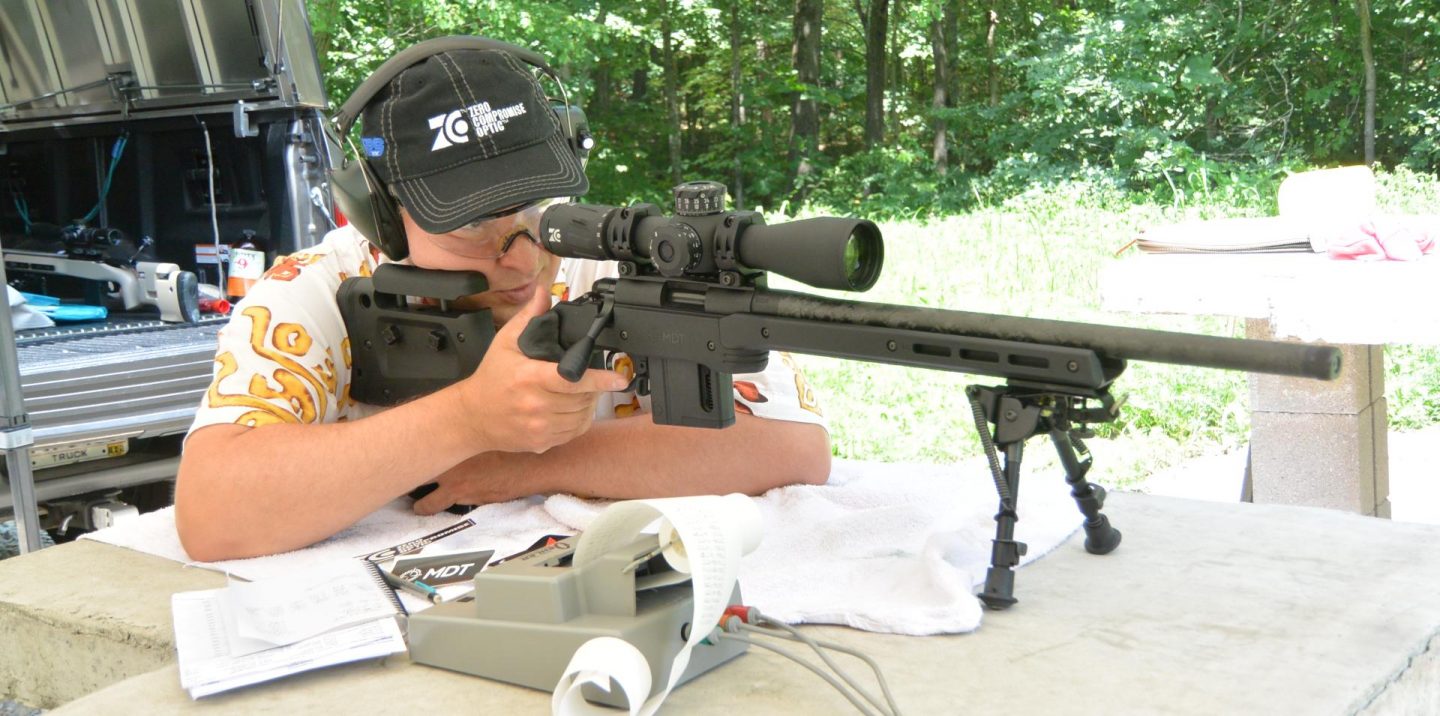
For a long time, U.S. gun makers, outside of a few small competitive disciplines, did not seem to feel that the .22lr was worthy of producing a quality adult firearm for. I didn’t understand that and Vudoo has clearly proven them wrong by selling so many in it’s first year that the whole industry was sent scrambling to play catch-up. Vudoo is not going to be easy to catch. I have found both the quality of their engineering and the quality of their manufacturing to be top notch and they have a few patents with some more pending besides. Furthermore, the research Mike spent so many years doing with 40x when it comes to chambering, barrels, and magazine feeding have combined to make the rifles they build reliably accurate on par with Olympic 3-position guns and sometimes even with benchrest rifles. I have more than a little data to back that up. Vudoo’s rifles are very easy turnkey solutions for high performance and they have priced them ($1320 for the action and $1770 for a barreled action) in such a way as to encourage you to go with the turnkey version instead of tying to LEGO it with your own barrel and smith. I think Vudoo has been smart to do this, as they have been able to maintain quality control on virtually every Vudoo out there without being that company that won’t sell you just an action. As for those who think it is crazy to spend $2k+ on a rimfire, that is what it costs to get into a custom level center fire rifle and what differences exist in manufacturing between centerfire and rimfire tend to land the rimfire on the more expensive side, so I have no idea why people expect a lower price.
Vudoo’s website does not make it immediately apparent that they are a full service custom rifle builder. It looks more like they just make a few set models. There is no itemized cost list of all available services or options. Until quite recently, their new single shot benchrest action wasn’t even mentioned and the recently released integrally suppressed .22lr or the 1-9 twist barrel options still aren’t. There are a lot of other options, such as cutting you an alternative chamber as with the EPS, doing a flat breach instead of their hybrid cone, or spinning up an alternative barrel such as the Proof carbon that my test rifle here has. For those interested, a Proof carbon adds $350 and you can substitute a Bartlein, Lothar Walther, Shilen, or Krieger for the house Ace barrel at no extra cost. I would not hesitate to go off menu with a Vudoo as I think their level of smithing is first rate. That being said, by coupling an off the shelf Vudoo built V-22 rifle or barreled action with the Lapua rimfire test center, it is just so easy to get a reliably functioning, high performing system that few will probably have much cause to delve into all the options available.
Vudoo has impressed me with the quality and consistency of their manufacturing and the performance of the resulting product, but perhaps even more so with their continuing innovation. Just in the time between when I started the review process and now they have put out both a new single shot action and also an integrally suppressed V-22. Clearly their two shop development and production system has its advantages. It will be interesting to continue to follow their developments in the future.
